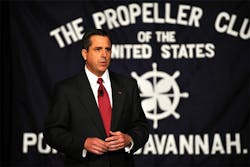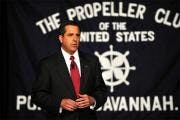Savannah Harbor Expansion Project receives green light
With President Obama’s signing of the Water Resources Reform and Development Act of 2014, the Savannah Harbor Expansion Project (SHEP) has been authorized to begin construction.
“SHEP has officially received a green light,” said Georgia Ports Authority Executive Director Curtis Foltz. “This project is the result of an open and collaborative process involving all interested stakeholders which received approval of multiple regulatory agencies. We would like to thank the administration, our elected officials throughout Georgia and Washington, Governor Deal, Senator Isakson, Senator Chambliss, Congressman Kingston and the entire congressional delegation, and all of those who worked tirelessly to reach this critical milestone.”
The next step for SHEP calls for Georgia to enter a Project Partnership Agreement (PPA) with the US Army Corps of Engineers, defining how the costs of the project estimated at $706 million will be shared between the state and federal government. Foltz said he expects to have a binding PPA within 90 days, allowing accelerated use of Georgia’s portion of the funding. These funds will be credited against the state’s ultimate cost share at the end of construction.
Seeing the port deepening through to final authorization has been a top priority for GPA Board Chairman Robert Jepson during his two years leading the board.
“The harbor deepening is recognized across Georgia as the state’s most important infrastructure project in terms of future economic development,” said Jepson. “Because Gov Nathan Deal and the General Assembly had the foresight to set aside $266 million toward construction, we will be able to start the project this year using state funds.”
Federal studies show that for every dollar invested in the deepening, the nation’s economy will reap $5.50 in net benefits. Lower prices per container slot on Post-Panamax vessels will save US companies moving goods through Savannah 20 to 40% on transportation. Port users can realize further savings on land transit because of the terminal’s adjacent network of distribution centers and its location 100 miles closer to Atlanta than any other port.
Jepson also noted the GPA board’s recent $86.5 million purchase of four new Super Post-Panamax ship-to-shore cranes and 20 new rubber-tired gantry cranes (RTGs)—set to start arriving in 2016. The board has also budgeted $8 million to continue the transition of Garden City’s RTG fleet from diesel to electric power – a move that will help the GPA avoid the use of millions of gallons of diesel each year.
Foltz said that at three million 20-foot equivalent container units (TEUs) per year, the Port of Savannah now moves four times the containers it handled when Congress initially authorized SHEP in 1999. He said improved efficiency will allow the GPA to more than double its annual throughput to 6.5 million TEUs without increasing the physical footprint of the 1,200-acre Garden City Terminal.
Georgia’s deepwater ports and inland barge terminals support more than 352,000 jobs throughout the state annually and contribute $18.5 billion in income, $66.9 billion in revenue, and $2.5 billion in state and local taxes to Georgia’s economy. The Port of Savannah handled 8% of the US containerized cargo volume and 10.9% of all US containerized exports in fiscal year 2013.
For more information, access www.gaports.com.

